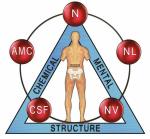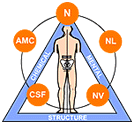


What is Applied Kinesiology
Applied Kinesiology (kih-nee'-see-awl'-oh-jee) is a a functional neurological assessment and treatment process that extends the neurological examination in both the medical and chiropractic context. Applied Kinesiology (A.K.) procedures provides an interactive and integrated assessment of the functional health status of the individual in real time which is not equipment intensive. Essentially, A.K. provides a window to the unique aspects of a patients nervous system.
This pioneering technique was originally developed by Dr. George Goodheart, a Michigan based chiropractor in 1964. Beginning with a small group of dedicated followers, the work continued to grow and eventually develop into an international academic organization called the International College of Applied Kinesiology (I.C.A.K.). Link to ICAK-usa description statement [PDF File].
Of the many advances in Applied Kinesiology (A.K.), the most well known is the diagnostic procedure called Muscle Testing [PDF File]. This procedure creates a monitored primary feedback mechanism between the nervous system and the skeletal muscles. A practitioner will often evaluate multiple skeletal muscles for imbalances to investigate causative factors that can compromise optimal health whether it be musculo-skeletal, emotional, neurological or systemic organ/glandular imbalances. A classical muscle test typically uses the straight-arm test (deltoid muscle) to evaluate how well the muscle will resist an externally variable force. If the muscle is capable of ‘resisting’ then the examiner can proceed with a second principle called therapy localization, a diagnostic scanning tool developed in 1974. This unique procedure can be used to ascertain the status of most neuro-physiological events in the body revealing whether an event is physical, chemical, emotional, or a memory. If a neuro-physiological receptor on the body service is identified to be in deficit, the muscle will exhibit that same deficiency as a weak muscle test. This method [PDF File], when properly applied, functions as an efficient diagnostic tool that guides the practitioner in an accurate diagnosis as well as development of an appropriate treatment.
A common symbol of A.K. is a triangle showing the primary foundation of health with an overlay of a circle with 5 additional smaller circles representing the primary common therapeutic modalities. Applied Kinesiologist may also use the name Professional Applied Kinesiologist (P.A.K.). This recent name change shows additional training and certification within applied kinesiologist practitioners whom have a license to diagnose. To learn more about this work visit the International College of Applied Kinesiology -United States chapter at www.icakusa.com. Dr. Corwin, D.C. has been a member since 1980.
Additional articles can be viewed on-line via
To learn more about Applied Kinesiology, visit:
- Applied Kinesiology Research Compendium [PDF File]
- Applied Kinesiology Face Book Page (short Video)


“The body heals itself in a sure, sensible, practical, reasonable, and observable manner. ‘The healer within’ can be approached from without. The opportunity to use the body as an instrument of laboratory analysis is unparalleled in modern therapy; if one approaches the problem correctly, making the proper and adequate diagnosis and treatment, the response is satisfactory to both the doctor and the patient.”
- George J. Goodheart, Jr. D.C., DIBAK (Founder of Applied Kinesiology 1965)
Manual Muscle Testing (MMT)
MMT is a phenomena commonly associated with Applied Kinesiology but also has a long history with many clinical studies and published papers to include:
- Reliability and Validity of Therapy Localization (abstract - 2015)
- Kendal et al. 2005, Panjabi 2006, and Cuthbert & Goodheart in 2007.
MMT is a sensory receptor based diagnostic tool which is used as a dynamic monitored primary feedback mechanism between the nervous system and the skeletal muscles.
Some of the main attributes of MMT * is to identify and monitor aberrant physiology between:
- Neurologic disorganization
- Viscerosomatic relationships (aberrant autonomic dysfunction)
- Toxic chemical influence
- Nutritional inadequacies
- Spinal segmental dysarthria
- Dysfunction of cranial bones & cerebral spinal fluid dynamics
- Adverse mechanical traction on spinal dura and meningeal membranes
- Myofascial dysfunction
- Peripheral and Cranial Nerve Entrapment
- Lymphatic and vascular impairment
- Meridian system imbalance
It should also be noted that neoplasms being non-nerve innervated thus not connected to the nervous system, renders MMT non-influential.
Academically, MMT is explained with standard neurophysiology:
Simply, all MMT ultimately is testing the Central Integrative State (CIS) of the ventral horn within the spinal cord. The CIS is influenced by both descending fibers from higher brain centers (to include reflexogenic systems within the cerebellum and brainstem) as well as incoming afferent stimulus from sense organs from the viscera and somatic tissues. The total effect of [aberrant] stimulus (synaptic activity) can be either inhibitory or excitatory extending its influence on the CIS which is measurable through a manual muscle test as a conditionally inhibited or conditionally facilitated muscle test.
Additional explanation of neurophysiological pathways involved in MMT also described by
Richard Belli, D.C., DACNB, FABNN
* Additional information is available in a recent publication,
"Applied Kinesiology Essentials" by Scott Cuthbert 2013
Gangassas Press ISBN: 978-0-9887452-1-6

